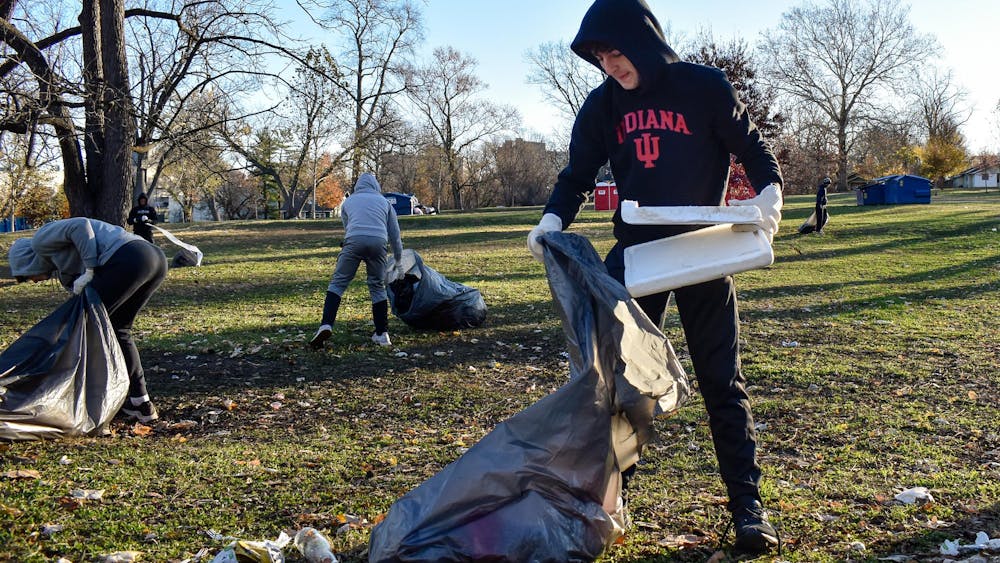In the past, when cars and people collided, it was the roads, lights and speed limits that had to change. Now, officials say, campus is difficult to change, and the best way to reduce accidents is to change attitudes.
Professors, students and staff have had serious and not-so-serious accidents, close calls and even deaths. On Sept. 9, sophomore Peter Duong died crossing Fee Lane. Since then, at least five people have reported being hit by a vehicle on campus.
The attitude shift and road changes might not come easily.
Bloomington isn’t as progressive as it thinks it is, especially when it comes to traffic issues, said Jim Rosenbarger of Bloomington’s Bicycle and Pedestrian Safety Commission.
Rosenbarger is concerned about 10th Street and the bypass, which he said is built like a highway.
“IU doesn’t support a pedestrian-friendly environment,” Rosenbarger said. “They still seem to be stuck in the 1960s and ’70s.”
Traffic problems near campus became painfully obvious in the late 1980s and early 1990s.
Distinguished Professor Emeritus of history Ssu-Yu Teng died in April 1988, months after being hit by a car on Atwater. After Teng’s death, history lecturer Lana Ruegamer collected more than 2,500 names on a petition for more safety measures on the street.
On December 30, 1988, an 8-year-old was also hit on Atwater and critically injured.
The Bloomington City Council then lowered the speed limit on the street from 30 to 25. But the council said it couldn’t legally justify adding traffic lights on the street because not enough people crossed it every day.
Four years later, another pedestrian was hit.
Mathematics Professor Emeritus Max Zorn died March 9, 1993, three months after being hit while crossing Third Street. This finally led to the City Council approving traffic signals.
Past solutions
To try to remedy traffic issues in years past, IU has closed off the “heart of campus.”
An A-pass is required to drive during the day down Seventh Street to the IU Auditorium, Ballantine Hall and other buildings.
IU Parking Operations issued 5,893 A-passes in the fall of 2009, said parking manager Doug Porter.
But, Hanson said, the heart of the campus has expanded. Having academic buildings on 10th Street and 17th Street means students, faculty and staff must dodge traffic on busy streets to get to classes, residence halls and labs.
It would be hard to close 10th and Seventh streets, but the city has been discussing different options to make 10th Street safer, such as making it a one-way.
As IU has expanded, campus parking has made the traffic issue tougher. According to preliminary drafts of IU’s master plan, parking on campus near the academic buildings fills up during the day, but parking near the stadium does not.
In the early 1990s, IU professor George Smerk wrote a transportation fee/bus pass plan, which he said he hoped would keep students’ cars away from campus.
Smerk said he wanted the fee to allow for more bike racks on campus, traffic signals at major crossings and a Capital Replenishment Program for parking operations, according to a 1992, Indiana Daily Student article.
“The idea behind the pass is to keep people from bringing their cars to the main campus – a very small area that won’t change,” said Smerk in the article.
Putting together a task force
After Duong’s death, Karen Hanson, provost and executive vice president of IU, assembled a 19-member “Bloomington Campus Safety Task Force,” co-chaired by Paul Sullivan, acting vice president for administration, and Kurt Zorn (unrelated to Max Zorn), a School of Public and Environmental Affairs professor and associate vice provost for undergraduate education.
Task force members include IU faculty, staff, representatives from the Bloomington
community and two students.
“Basically the charge from Provost Hanson was to look at the issue of traffic and of course pedestrian safety on the Bloomington campus, with specific attention being paid to the Fee Lane area, but not exclusively to Fee Lane,” Kurt Zorn said.
Kurt Zorn said he thought a solution to the traffic problem would be more crosswalks, until he learned pedestrians don’t have the right-of-way at crosswalks that cut through streets – the ones that aren’t at intersections – unless there is a stop sign or signal light.
Ideas have been discussed by the task force, but a big part of the solution should be education and a change of attitude, he said.
“The thing that gets lost on people, for the size of the campus and the number of people, students, faculty, staff that traverse the campus regularly, we have a remarkable safety record,” he said. “Now that’s not all that satisfactory when you have a death on Fee Lane.”
He said looking both ways and being cautious before crossing a street, like many were taught as children, is useful but often unheeded. Everyone needs to be more careful, he said.
“It’d be nice if everyone just slowed down a little bit, paid attention,” he said.
Sophomore Scott Williamson, a task force member and IU Student Association director of government relations, agreed.
“An important part of this is changing our attitudes so people are more aware of the rules about pedestrians and crosswalks in Indiana and the safest way to be a pedestrian,” Williamson said.
Safety Series Part 1: Traffic concerns plague IU’s campus through the years
Get stories like this in your inbox
Subscribe





